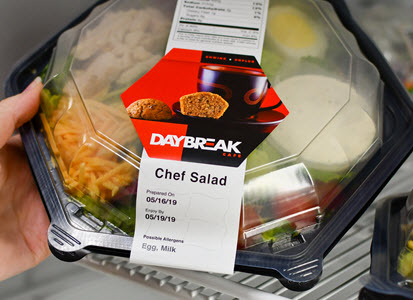Four Ways to Increase Efficiencies Through Automation
Posted on 28th Jul 2021
 By playing to their strengths–brand availability and loyalty, the physical in-store experience, and customer satisfaction–and by investing in technology solutions that help streamline the many tasks that come with managing operations, operators can remain competitive, increase worker productivity, and offer safer food options.
By playing to their strengths–brand availability and loyalty, the physical in-store experience, and customer satisfaction–and by investing in technology solutions that help streamline the many tasks that come with managing operations, operators can remain competitive, increase worker productivity, and offer safer food options.
Automated systems, such as DayMark’s MenuCommand® kitchen automation platform, offer applications that make the investment in automation both efficient and cost-effective. Here are the top four ways to increase efficiencies through automation, including food safety labeling, task management, receiving, and food temperature monitoring.
1. Food Labeling
A custom, web-based labeling system provides basic information such as safe handling instructions, date and time the food was prepared, and nutritional information, including an FDA-compliant label for grab-n-go foods. DayMark, for example, pairs its system with the Matt85™ and Matt77™ Bluetooth-enabled direct thermal printers that allow for quick and easy label printing. With wireless technology, labels can be printed on-demand, reducing label inventory and saving money.
Additionally, recipe information and training videos can be uploaded at a central location and automatically shared with all connected store locations. This allows staff members to easily access these materials, be better prepared to handle ever-changing processes, and increases consistency across multiple locations.
2. Temperature Checks
One key to food safety is regular temperature checks, including cold holding in refrigeration units as well as food checks in hot hold situations. In the past, monitoring temperatures was tedious and sometimes ineffective as staff members manually checked and recorded temperatures in a handwritten log. Automated monitoring systems, such as the DayMark Temp Monitoring Solution featuring the cutting-edge LoRa technology from JRI®, offer HACCP-compliance and provides food safety management and temperature monitoring through an intuitive and comprehensive web application, either wirelessly or through a hardwired connection. The system eliminates the need for staff to manually check temperatures and is an accurate and reliable way to make sure all foods are stored and cooked correctly.
3. Workforce Efficiency
Confronted with a nationwide worker shortage, retail food operators must focus on streamlining worker tasks. By utilizing a web-based task management application, operators are able to document the progress of ongoing operations in both the front- and back-of-house quickly and efficiently with a variety of tools, including task organization, flexible scheduling, and recording of daily health details.
4. Receiving
Many retail food operators are using apps designed to streamline the receiving process. This technology gives retail food operators the ability to create custom, item-specific non-conformances that identify and document orders that are short, out-of-spec, or otherwise incorrect. DayMark’s version knows as the Receiving Module, also can be used to adjust expected shipment status and keep open deliveries on hold based on delays or other incomplete information.
Operators looking to utilize these kitchen automation tools, or other foodservice applications to increase efficiencies, should look for solutions that are effective, yet easy to use. Some companies even offer free web demos to help with learning new technology.
Article originally appeared on the Supermarket Perimeter website.


